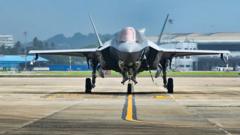What Happened to the British Jet Stuck in India?

Understanding the Stranding of the F-35B: A Detailed Analysis
In recent weeks, a highly advanced British fighter jet, the F-35B, has become the center of attention after being stranded at Thiruvananthapuram airport in India for nearly three weeks. The situation has not only sparked curiosity among aviation enthusiasts and defense analysts but has also raised important questions regarding military logistics, international cooperation, and the operational readiness of advanced military technology. In this article, we will delve into the circumstances surrounding the F-35B's predicament, explore the implications of its stranding, and analyze what this means for the British Royal Navy and international military relations.
The Incident: How Did the F-35B Get Stranded?
The F-35B, a state-of-the-art stealth fighter jet developed by Lockheed Martin, was on a routine sortie in the Indian Ocean when it encountered adverse weather conditions, leading to its diversion to Thiruvananthapuram airport in Kerala, India, on June 14. The aircraft was unable to return to its carrier, HMS Prince of Wales, due to technical issues that arose upon landing.
The Technical Snag
Upon landing, engineers from HMS Prince of Wales assessed the F-35B and discovered a technical snag that has since prevented its return to operational service. The Royal Navy has stated that the aircraft has been moved to a Maintenance Repair and Overhaul facility at the airport, where it awaits the arrival of UK engineering teams equipped with the necessary specialist tools to carry out repairs.
Security Concerns and International Cooperation
Given the sensitive nature of military equipment and the advanced technologies involved in the F-35B, security has been a paramount concern during this incident. The British High Commission has reassured the public that the aircraft is being guarded around the clock by personnel from the Royal Air Force (RAF). With six officers on duty, the intent is to ensure that the aircraft remains secure while it is grounded in a foreign country.
Collaboration with Indian Authorities
The UK government has expressed its gratitude toward Indian authorities for their cooperation and support during this unusual situation. As the jet undergoes repairs, ground teams from both nations are working closely to ensure that safety and security protocols are followed diligently. The presence of RAF crew members alongside the aircraft is an indication of the UK's commitment to maintaining control over the situation.
The Implications of the F-35B's Stranding
The continued presence of the F-35B at Thiruvananthapuram airport has sparked significant debate among defense analysts and military experts. Dr. Sameer Patil, director of the Centre for Security, Strategy and Technology at the Observer Research Foundation in Mumbai, has pointed out that the longer the aircraft remains stranded, the more it can adversely affect the credibility of both the F-35B and the Royal Navy.
Public Perception and Media Reaction
Social media has played a pivotal role in shaping public perception of the stranded jet. Images of the "lonely F-35B" parked on the tarmac, soaked by the Kerala monsoon rains, have been widely circulated, leading to a flood of memes and jokes. Some users humorously suggested that the jet should be listed for sale online, while others joked about the jet deserving Indian citizenship due to its extended stay.
- One viral post humorously priced the jet at $4 million, listing features like "automatic parking" and "brand-new tires."
- Kerala's tourism department even joined the fun, posting an AI-generated image of the jet with palm trees, promoting the state as a destination visitors never want to leave.
While humor can lighten the situation, Dr. Patil warns that the ongoing discourse could lead to damaging rumors and conspiracy theories, further complicating the jet's image and the Royal Navy's reputation.
Logistical Challenges and Future Considerations
As the situation unfolds, questions arise about the logistics involved in repairing or relocating the F-35B. Two primary options have been proposed by experts: either the aircraft can be repaired on-site and returned to operational status or it could be transported out of India using a larger cargo aircraft, such as the C-17 Globemaster. Each option presents unique challenges, particularly concerning the safeguarding of classified technologies and the timeline for resolution.
Operational Readiness of the Royal Navy
The stranding of the F-35B has raised questions about the operational readiness of the Royal Navy and its ability to respond to unforeseen circumstances. Dr. Patil emphasizes the importance of having a standard operating procedure (SOP) in place for such situations. He questions why it has taken so long to address the technical issues, especially since protocols typically exist for dealing with aircraft stranded in foreign territories.
Additionally, the optics of this incident could have significant ramifications. If such a scenario had occurred in enemy territory, the response might have been more urgent, highlighting the importance of military preparedness and operational efficiency.
The Future of the F-35B and the Royal Navy
As we look ahead, the future of the F-35B remains uncertain. The successful repair and return of the aircraft to active service are crucial not just for the Royal Navy, but also for maintaining the credibility of the UK's military capabilities. The ongoing discourse surrounding the jet's stranding serves as a reminder of the challenges faced by modern militaries in an increasingly interconnected world.
Moreover, the incident highlights the importance of international collaboration and communication between nations, especially in times of crisis. The cooperation between the UK and India during this episode has demonstrated the potential for strengthening ties and enhancing military partnerships.
Conclusion: Lessons Learned from the F-35B Incident
The case of the stranded F-35B offers valuable lessons for military organizations worldwide. As defense technology continues to advance, so too must the strategies and protocols that govern their deployment and maintenance. This incident serves as a reminder of the complexities involved in military logistics, international cooperation, and the management of sensitive technologies.
Ultimately, the hope is that the F-35B will soon return to operational status, allowing the Royal Navy to continue its important work. As the situation develops, it will be interesting to observe how military organizations adapt and learn from such challenges in the future.
FAQs About the Stranded F-35B
What caused the F-35B to become stranded in India?
The F-35B was diverted to Thiruvananthapuram airport after encountering bad weather during a sortie in the Indian Ocean, which led to a technical snag that has prevented its return to the HMS Prince of Wales.
How is the security of the F-35B being managed while it is stranded?
The aircraft is being guarded 24/7 by six officers from the Royal Air Force, and ground teams are working closely with Indian authorities to ensure safety and security precautions are observed.
What options does the Royal Navy have for recovering the F-35B?
The Royal Navy has two main options: they can repair the aircraft on-site or transport it out of India using a larger cargo aircraft like the C-17 Globemaster.
The situation surrounding the stranded F-35B raises significant questions about military operations and the complexities of modern defense logistics. As we follow this story, it will be essential to keep an eye on how the Royal Navy and UK government respond to ensure the aircraft is returned to active service. What are your thoughts on the impact of this incident on military credibility? #F35B #RoyalNavy #MilitaryLogistics
Published: 2025-07-04 02:52:17 | Category: technology



